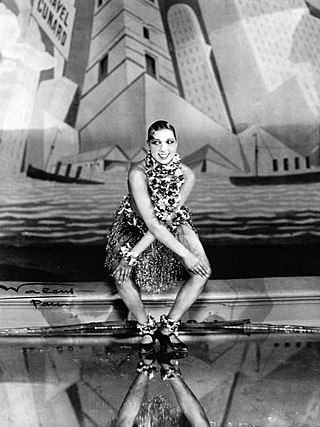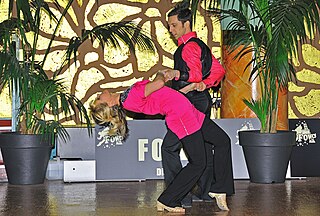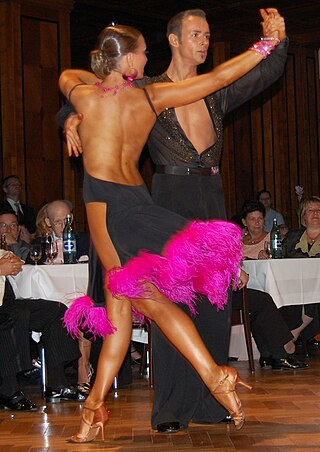
Ballroom dance is a set of European partner dances, which are enjoyed both socially and competitively around the world, mostly because of its performance and entertainment aspects. Ballroom dancing is also widely enjoyed on stage, film, and television.
In partner dancing, connection is physical, non-verbal communication between dancers to facilitate synchronized or coordinated dance movements. Some forms of connection involve "lead/follow" in which one dancer directs the movements of the other dancer by means of non-verbal directions conveyed through a physical connection between the dancers. In other forms, connection involves multiple dancers without a distinct leader or follower. Connection refers to a host of different techniques in many types of partner dancing, especially those that feature significant physical contact between the dancers, including the Argentine Tango, Lindy Hop, Balboa, East Coast Swing, West Coast Swing, Salsa, and other ballroom dances.

East Coast Swing (ECS) is a form of social partner dance. It belongs to the group of swing dances. It is danced under fast swing music, including: big band, rock and roll, rockabilly, and boogie-woogie.
In some types of partner dance, lead and follow are designations for the two dancers' roles in a dance pairing. The leader is responsible for guiding the couple and initiating transitions to different dance steps and, in improvised dances, for choosing the dance steps to perform. The leader communicates choices to the follower, and directs the follower by means of subtle physical and visual signals, thereby allowing the pair to be smoothly coordinated.

The Charleston is a dance named after the harbor city of Charleston, South Carolina. The rhythm was popularized in mainstream dance music in the United States by a 1923 tune called "The Charleston" by composer/pianist James P. Johnson, which originated in the Broadway show Runnin' Wild and became one of the most popular hits of the decade. Runnin' Wild ran from 28 October 1923 through 28 June 1924. The Charleston dance's peak popularity occurred from mid-1926 to 1927.

West Coast Swing is a partner dance with roots in Lindy Hop, characterized by an elastic look that results from its extension-compression technique of partner connection and is danced primarily in a slotted area on the dance floor. The dance allows for both partners to improvise steps while dancing together, putting West Coast Swing in a short list of dances that emphasize improvisation.

Swing dance is a group of social dances that developed with the swing style of jazz music in the 1920s–1940s, with the origins of each dance predating the popular "swing era". Hundreds of styles of swing dancing were developed; those that have survived beyond that era include Charleston, Balboa, Lindy Hop, and Collegiate Shag. Today, the best-known of these dances is the Lindy Hop, which originated in Harlem in the early 1930s. While the majority of swing dances began in African-American communities as vernacular African-American dances, some influenced swing-era dances, like Balboa, developed outside of these communities.

Salsa is a Latin dance, associated with salsa music, which was first popularized in the United States during the 1960s in New York City. Salsa is a mixture of Cuban dances, such as mambo, pachanga, and rumba, as well as American dances such as swing and tap.

In partner dancing, closed position is a category of positions in which partners hold each other while facing at least approximately toward each other.

Partner dances are dances whose basic choreography involves coordinated dancing of two partners, as opposed to individuals dancing alone or individually in a non-coordinated manner, and as opposed to groups of people dancing simultaneously in a coordinated manner.

Social dances are dances that have social functions and context. Social dances are intended for participation rather than performance. They are often danced merely to socialise and for entertainment, though they may have ceremonial, competitive and erotic functions.
This is a list of dance terms that are not names of dances or types of dances. See List of dances and List of dance style categories for those.
Cajun Jitterbug is a style of Cajun dancing with two variations. The main style is a classic two-step form of a six-count East Coast Swing, which is differentiated from the one-step Cajun Jig. The other is considered a cowboy-style of Jitterbug or swing dance, also referred to as the Lake Charles Slide, the Cowboy Jitterbug and the Whiskey River Jitterbug.
The Texas Tommy is a vigorous social dance for couples that originated in San Francisco in the early twentieth century.
The country/western two-step, often called the Texas two-step or simply the two-step, is a country/western dance usually danced to country music in common time. "Traditional [Texas] two-step developed, my theory goes, because it is suited to fiddle and guitar music played two-four time with a firm beat [found in country music]. One-two, one-two, slide-shuffle. The two-step is related to the polka, the Texas waltz, and the jitterbug.
The Texas two-step is the same step known to ballroom dancers as the international fox-trot. Except for the one-step, which is just that, most Texas dances are variations of a two-step, also called a half-step, which is simply a step-close-step. The Texas two-step is generally done with two long steps and a step-close-step to two-four time. Speeded up, it's a shuffle or double shuffle, but still a two-step.

Benjiman Daniel Schwimmer is an American professional dancer, choreographer, actor and director. He was the winner of the second season of So You Think You Can Dance (2006) and has choreographed for both the U.S. and the international versions of the show. He is the only dancer in the world to hold World titles in solo, partner and group divisions at the same time. Schwimmer works on TV, film and stage both in front and behind camera. He was the specialties choreographer for Quentin Tarantino's "Once Upon a Time In Hollywood".
Lacey Mae Schwimmer is an American ballroom dancer and singer. She is best known as a fourth place finalist of the third season of So You Think You Can Dance. She is the daughter of noted dancer Buddy Schwimmer, as well as the cousin of Heidi Groskreutz, who placed fourth on the second season of So You Think You Can Dance and younger sister of Benji Schwimmer, the winner of the show's second season. She participated in the seventh season of Dancing with the Stars as a professional dancer paired with Lance Bass of 'N Sync, in the eighth season of the show paired with Jackass star Steve-O and in the ninth season paired with actor and Iron Chef America host Mark Dacascos. Schwimmer returned to Dancing with the Stars for its eleventh season and she was partnered with Disney Channel star Kyle Massey and in the 12th season, paired with radio host Mike Catherwood. In the thirteenth season, she was paired with transgender activist Chaz Bono. Schwimmer did not return for season 14 of Dancing With The Stars'.
The Collegiate Shag is a partner dance done primarily to uptempo swing and pre-swing jazz music. It belongs to the swing family of American vernacular dances that arose in the 1920s and 30s. It is believed that the dance originated within the African American community of the Carolinas in the 1920s, later spreading across the United States during the 1930s. The shag is still danced today by swing dance enthusiasts worldwide.









